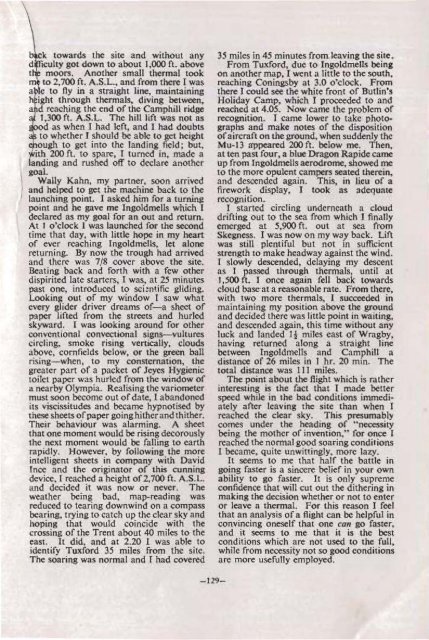Gliding 1950 - Lakes Gliding Club
Gliding 1950 - Lakes Gliding Club
Gliding 1950 - Lakes Gliding Club
Create successful ePaper yourself
Turn your PDF publications into a flip-book with our unique Google optimized e-Paper software.
ck towards the site and without any<br />
d culty got down to about 1,000 ft. above<br />
t moors. Another small thermal took<br />
m to 2,700 ft. A.S.L, and from there I was<br />
e to fly in a straight line, maintaining<br />
h ight through thermals, diving between,<br />
a d reaching the end of the Camphill ridge<br />
E1,300 ft. A.S.L. The hill lift was not as<br />
d as when I had left, and I had doubts<br />
. to whether I should be able to get height<br />
ough to get into the landing field; but,<br />
)Yith 200 ft. to spare, I turned in, made a<br />
-landing and rushed off to declare anOther<br />
goal.<br />
Wally Kahn, my partner, soon arrived<br />
and helped to get the machine back to the<br />
\ launching point. I asked him for a turning<br />
point and he gave me IrrgoldmeUs which I<br />
declared as my goal for an out and return.<br />
At 1 o'clock I was launched for the second<br />
time that day, with little hope in my heart<br />
of ever reaching Ingoldmells, let alone<br />
returning. By now the trough had arrived<br />
and there was 7/8 cover above the site.<br />
Beating back and forth with a few other<br />
dispirited late starters, I w,as, at 25 minutes<br />
past one, introduced to sci:ntific gliding.<br />
Looking out of my window I saw what<br />
every glider driver dreams of-a sheet of<br />
paper lifted from the streets and hurled<br />
skyward. I was looking around for other<br />
conventional convectionaJ signs-vultures<br />
circling, smoke rising vertically, clouds<br />
above, cornfields below, or the green ball<br />
rising-when, to my consternation, the<br />
greater part of a packet of Jeyes Hygienic<br />
toilet paper was hurled from the window of<br />
a nearby Olympia. Realising the variometer<br />
must soon become out ofdate, I abandoned<br />
its viscissitudes and became hypnotised by<br />
these sheets ofpaper goinghitherand thither.<br />
Their behaviour was alarming. A sheet<br />
that one moment would be rising decorously<br />
the next moment would be falling to earth<br />
rapidly. However, by following the more<br />
intelligent sheets in eompany with David<br />
[nce and the originator of this cunning<br />
device, I reached a height of2,700 ft. A.S.L.<br />
and decided it was now or never. The<br />
weather being bad, map-reading was<br />
reduced to tearing downwind on a compass<br />
bearing, trying to catch up the clear sky and<br />
hoping that would coincide with the<br />
crossing of the Trent about 40 miles to the<br />
east. It did, and at 2.20 I was able to<br />
identify Tuxford 3.5 miles from the site.<br />
The soaring was normal and Thad covered<br />
35 miles in 45 minutes from leaving the site.<br />
From Tuxford, due to IngoldmeJls being<br />
on another map, I went a little to the south,<br />
reaching Coningsby at 3.0 o'clock, From<br />
there I couJd see the white front of Butlin's<br />
Holiday Camp, which I proceeded to and<br />
reached at 4.05. Now came the problem of<br />
recognition. I came lower to take photographs<br />
and make notes of the disposition<br />
ofaircraft on the ground, when suddenly the<br />
Mu-13 appeared 200 ft. below me. Then,<br />
at ten past four, a blue Dragon Rapide came<br />
up from Ingoldmells aerodrome, showed me<br />
to the more opulent campers seated therein,<br />
and descended again. This, in lieu of a<br />
firework display, I took as adequate<br />
recognition.<br />
I started circling underneath a cloud<br />
drifting out to the sea from which I finally<br />
emerged at 5,900 ft. out at sea from<br />
Skegness. I was now on my way back. Lift<br />
was still plentiful but not in sufficient<br />
strength to make headway against the wind.<br />
I slowly descended, delaying my descent<br />
as I passed through thermals, until at<br />
),500 ft. I -once again fell back towards<br />
cloud base'at a reasonable rate. From there,<br />
with two more thermals, I succeeded in<br />
maintaining my pOsition above the ground<br />
and decided there was little point in waiting,<br />
and descended again, this time without arty<br />
luck and landed q miles east of Wragby,<br />
having returned along a straight line<br />
between Ingoldmells and Camphill a<br />
distance of 26 miles in I hr. 20 min. The<br />
totaJ distance was 111 miles.<br />
The point about the flight which is rather<br />
interesting is the fact that I made better<br />
speed while in the bad conditions immediately<br />
after leaving the site than when I<br />
reached the clear sky. This presumably<br />
comes under the heading of "necessity<br />
being the mother of invention," for once I<br />
reached the normal good soaring condi'ions<br />
I became, quite unwittingly, more lazy.<br />
It seems to me that half the battle in<br />
going faster is a sincere belief in your own<br />
ability to go faster. It is only supreme<br />
confidence that will cut out the dithering in<br />
making the decision whether or not to enter<br />
or leave a thermaL For this reason I feel<br />
that an analysis ofa flight can be helpful in<br />
convincing oneself that one can go faster.<br />
and it seems to me that it is the best<br />
conditions which are not used to the full,<br />
while from necessity not so good conditions<br />
are more usefully employed.<br />
-129-

















